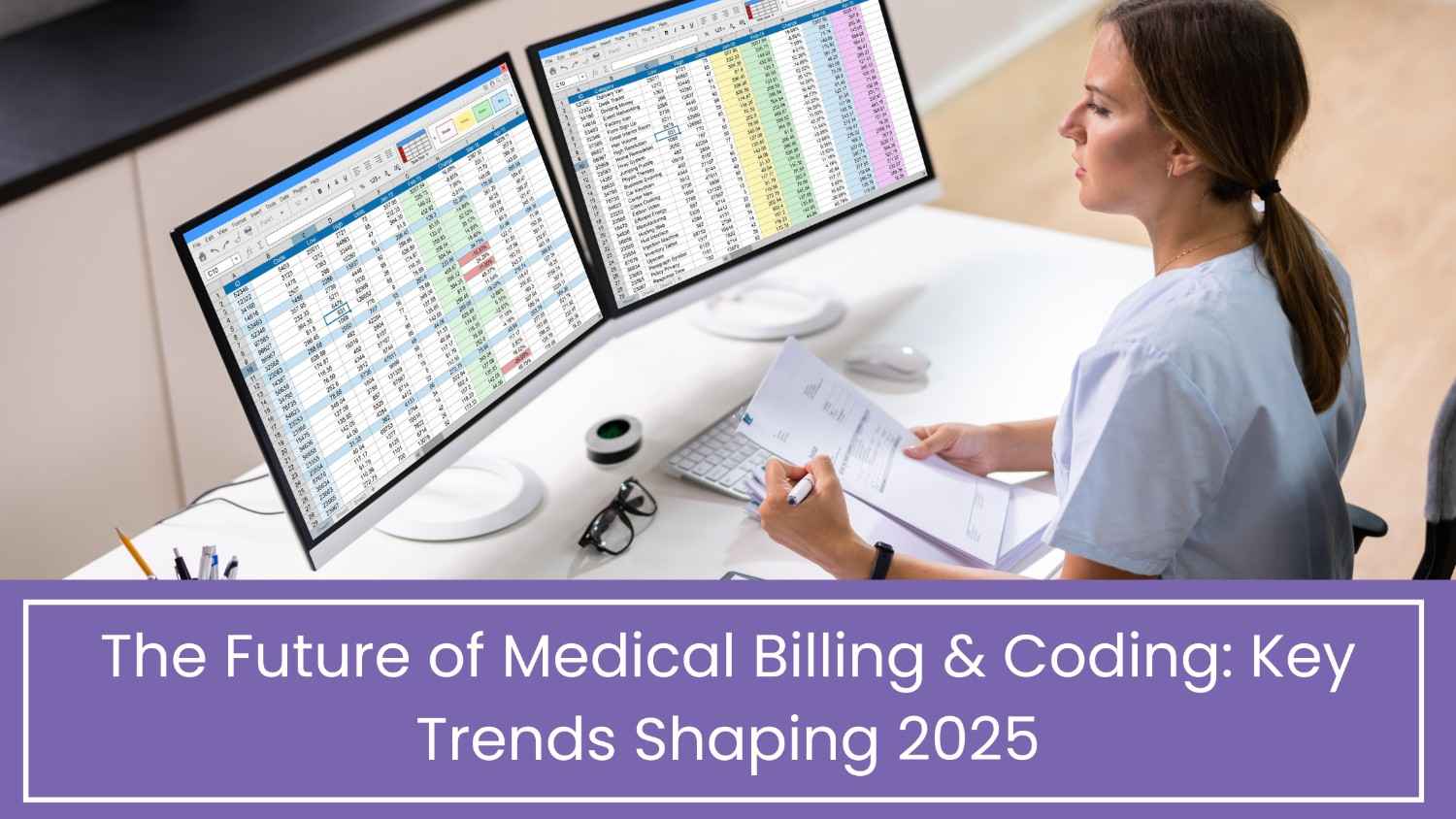The Future of Medical Billing & Coding: Key Trends Shaping 2025
The landscape of medical billing and coding is undergoing a profound transformation in 2025, driven by the growing influence of value-based care, automation, artificial intelligence, and heightened patient financial responsibility. No longer confined to back-office operations, these functions have become vital to both healthcare delivery and revenue optimization. The Future of Medical Billing & Coding: Key Trends Shaping 2025 highlights how providers can navigate this evolving environment with a forward-thinking mindset. A successful revenue cycle now requires a blend of technical expertise, data fluency, and a patient-centred approach.
Table of Contents
Medical Billing and Coding in 2025: Navigating the New Era of Technology, Transparency, and Value-Based Care
Technological developments, changing regulatory requirements, and a fundamental shift in healthcare delivery paradigms are all driving changes in the medical billing and coding scene. The ‘back office’ chores of medical billing and coding are evidently strategic imperatives as we navigate 2025, rather than merely administrative duties. They are essential to ensuring financial stability, operational efficacy, and ultimately, high-quality patient care.
This blog post will explore the major themes influencing medical billing and coding in 2025 and provide advice on how practices might prosper in the face of these revolutionary developments.
1. The Accelerated Rise of AI and Automation
Robotic process automation (RPA) and artificial intelligence (AI) are essential to medical coding and billing. By 2025, these technologies will be integrated:
- AI-driven technologies: use Natural Language Processing (NLP) to scan clinical records. These technologies make accurate suggestions for CPT and ICD codes. Before filing, claims might be examined to find errors in the coding or problems with compliance. This enhances first-pass resolution and reduces denial rates.
- Enhanced Eligibility Verification: By using past payer behavior to anticipate possible coverage concerns, AI automates real-time insurance eligibility and benefits verification, going above and beyond simple checks.
- Predictive analytics uses machine learning algorithms: To determine which claims are most likely to be rejected, these algorithms examine past claim data. Billing teams are able to proactively resolve problems as a result. It enables them to develop targeted appeals and minimize revenue loss.
- RPA for Repetitive jobs: Data input, payment posting, claims status checks, and even the creation of initial appeals letters are among the high-volume, routine jobs that are being replaced by bots. This gives human employees more time to concentrate on complicated problems that need for human judgment and critical thinking.
- The impact? Quicker processing times, less mistakes made by people, lower administrative expenses, and a more efficient revenue cycle. As a result of this change, the duties of a medical biller and coder are changing from data input to strategic analysis, problem-solving, and supervision.
2. The Dominance of Value-Based Care Models
2025 is experiencing a shift from fee-for-service to value-based care. This shift is ongoing. This major change considers efficiency, quality indicators, and patient outcomes when determining payment. Volume of services rendered is still a factor, but now, these other factors are also taken into account.
For medical billing and coding, this translates to:
- Coders and billers need to comprehend how clinical documentation supports quality metrics in order to use outcome-driven documentation. Maximizing reimbursement under VBC models requires precise and thorough charting that takes into account the patient’s health outcomes, preventive care, and care coordination initiatives.
- Population Health Management: Billing teams must comprehend capitation, pooled savings plans, and bundled payment methods. This calls for data analysis across patient populations as well as per patient, with an emphasis on managing chronic diseases and providing preventive care.
- The accurate coding of risk adjustments is crucial in VBC. Hierarchical Condition Categories (HCCs) and other risk assessment techniques have a direct effect on the capitated payments that providers receive. Coders are responsible for accurately recording patient acuity in the documentation.
- Data Analytics for Performance: To monitor performance against VBC indicators, spot care gaps, and inform payers of quality outcomes, billing professionals need to be adept at using data analytics technologies.
- Coders and billers must have a more comprehensive grasp of patient care in order to comply with this trend, which calls for a greater integration of clinical and financial data.
3. Interoperability and Seamless Data Exchange
By 2025, the goal of establishing a fully networked healthcare environment is starting to take form. The extensive usage of Fast Healthcare Interoperability Resources APIs and initiatives like the Trusted Exchange Framework and Common Agreement are making it easier and safer to move patient data between various systems, such as lab systems, pharmacies, EHRs, and even billing platforms.
What this means for medical billing and coding:
- Decreased manual entry saves time and reduces errors. This is due to the fact that improved interoperability lessens the necessity of human data entry.
- Data accuracy improves with real-time data flow. This ensures billing information is up to date and consistent across all platforms.
- Billers and coders are better able to comprehend patient care pathways. This improved understanding leads to better care coordination. This understanding helps them handle complex coding situations and determine medical necessity.
- Faster Reimbursements: From the first patient interaction to the filing and payment of claims, streamlined data exchange speeds up the whole revenue cycle.
- Systems that “talk” to one another are necessary for the future. This allows for the elimination of fragmented, segregated data.
4. Heightened Focus on Patient Financial Responsibility and Price Transparency
The involvement of patients in healthcare expenses is growing. As out-of-pocket expenses increase, high-deductible health plans are making this tendency worse. This trend and evolving price transparency regulations (such the No Surprises Act) will make patient financial experience a strategic objective in 2025.
Key implications for billing and coding:
- Upfront Cost Estimates: Before treatments are delivered, practices are required to give patients precise, customized cost estimates that include insurance benefits with recognized CPT codes.
- Flexible payment options are available. These options include online payment gateways, clear payment schedules, and financial counseling.
- Patient portals offer tools for retrieving financial information. They also enable patients to process payments and address billing inquiries.
- Patients need bills that are easy to read. They should include information about charges and insurance changes. This proactive communication reduces billing disputes. It also improves patient satisfaction.
- Patient advocacy is a growing trend in healthcare. Billing staff are now playing a key role in helping patients understand complex invoices.
- The billing department is becoming a more important touchpoint for patient satisfaction and loyalty, and it directly affects patient balance collection rates.
5. Cybersecurity and Data Privacy as a Non-Negotiable
The increased computerization of medical billing and medical coding raises the possibility of hacking. This increased reliance on technology makes the possibility of hacking greater than ever. Patient information is valuable and sensitive. Due to this, hackers target healthcare sector the most. However, by 2025, strict data privacy regulations and robust cybersecurity will be crucial. They will no longer be merely legal requirements.
This means:
- In order to enhance data privacy, advanced kind of security protocols are put into place. It includes high-level threat detection systems, multi-factor authentication, and end-to-end encryption. Security measures are improved by these protocols.
- Consistent adherence to HIPAA regulations is referred to as HIPAA compliance. It also includes state-specific privacy laws and other emerging data protection regulations. It is essential to train employees on data security best practices. Regular audits are also very important.
- The cybersecurity of software suppliers, cloud providers, and billing services is verified by third-party vendor vetting. It ensures that strong security measures are in place at these companies.
- Incident Response Planning: A well-defined incident response plan is required to mitigate the effects of a data breach. This approach should be regularly assessed to ensure its effectiveness.
- Maintaining trust, avoiding harsh financial fines, and preventing reputational harm all depend on protecting patient information.
Conclusion
2025 will see a dynamic, technologically advanced future for medical billing and coding. This future will emphasize value, data, and patient experience. Claims processing alone is a thing of the past. Billing and coding professionals need to be strategic thinkers. They also need to be skilled navigators of technology and sympathetic communicators.
Interoperability, cybersecurity, value-based care models, artificial intelligence and automation, and patient financial transparency are some of the major advancements. These are fundamental changes in healthcare, not only fads. In order to maximize income and lessen administrative burden in the years to come, proactive expenditures in employee training, technology adoption, and strategic alliances will be essential. These investments will also enable providers to deliver top-notch treatment. The goal of medical billing and coding is to create a more patient-centered healthcare system. The goal is also to make the system more efficient and resilient.
ALSO READ – Simplifying Revenue Management: How Medical Billing Services Empower Small Practices
Talk to Medical Billing Expert Today — Get a Free Demo Now!






